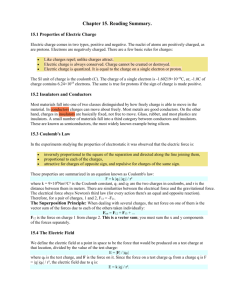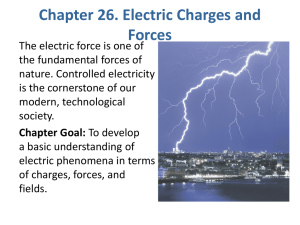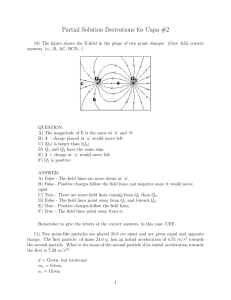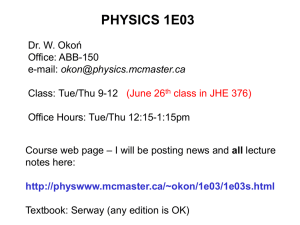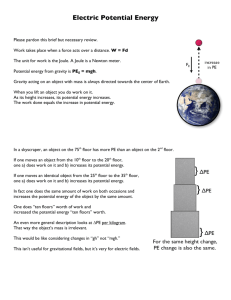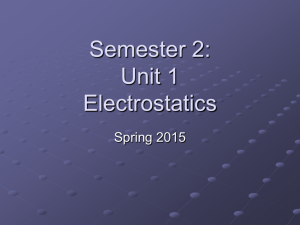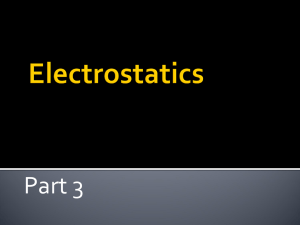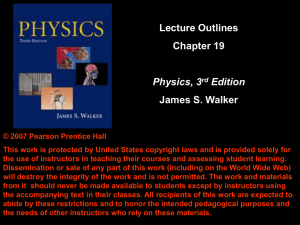Electric Fields - Kennesaw State University College of Science and
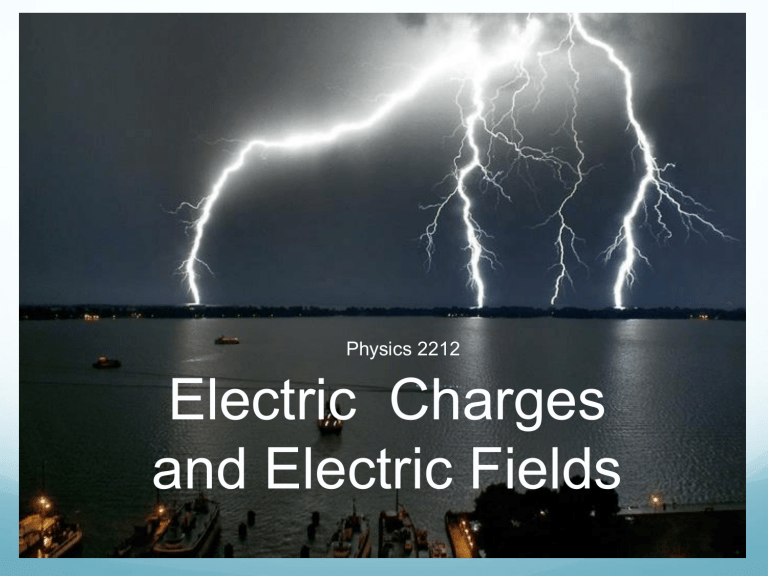
Physics 2212
Electric Charges and Electric Fields
Chapter 23
Properties of Electric Charges
Charging Objects by Induction
Coulomb’s Law
The Electric Field
Electric Field of continuous Charge distribution
Electric Field Lines
Motion of a charge particle in a uniform electric field
Charge Properties
Positive (+)
Negative (-)
Neutral (0)
Charges of the same sign repel
Charges of opposite sign attract
Electric Charge
The total electric charge of the universe is a constant:
Electric charge is conserved
Electric charge is quantized
When an atom loses electron it becomes positively charged
– Positive Ion
An atom that has gained an electron is now negatively charge – negative ion
Electric Charge
All elections have the same charge
In a cloud surrounding the nucleus
Charge on Proton has the same magnitude with opposite sign
Proton charge is in inside the Nucleus
Charging objects by Induction
Conductors : Materials in which some of the electrons are free electrons that are not bound to individual atoms and can move relatively freely through the material. Most metals are conductors.
Insulators are materials in which electrons are bound to individual atoms and cannot move freely through the material. Most insulators are non-metals.
Insulators and Conductors
When conductors carry excess charge, the excess is distributed over the surface of the conductor.
Insulators do not allow the movement of charge.
Semiconductors allow movement of charge in some cases but not others.
Charging by Induction
Electric Charges are at rest when the electric field within a conductor is zero.
The electric field is always perpendicular to the surface of a conductor – if it were not, the charges would move along the surface.
Charging by Induction
Excess charge on a conductor is free to move, the charges will move so that they are a far apart as possible. The excess charge on a conductor will reside on the surface.
Charging by Induction
Conductor must be grounded
Charges leave the conductor if conductor isolated by the rod is removed, only the excess charge remains
Coulomb’s Law
Coulombs Law states that the electric force exerted by a point charge q1 on a second charge q2 is r ^
12
Where r is the distance between two charges and r ^
12 is a unit vector directed form q
1 q
2
. toward
Coulomb’s Law Continued
Coulomb constant
k e
K e
= 8.99 x 10 9 N m 2 /C 2
= 1/4πε
0
Permittivity of free space
ε
0
= 8.8542 x 10 -12 C 2 /N m 2
Electric Force
Coulomb’s Law
Force on the two charges are action-reaction forces
Coulomb’s Law
In the case of multiple point charges the forces add by superposition; in general you must break vectors into their components to add the forces.
Find the Resultant Force
Consider three point charges located at the corners of a right triangle, where q
1
=5.00 μC, q
2
= q
3
= 22.00 μC, and a=0.100 m. Find the resultant force exerted on q
3.
Electric Field
The Electric field E at some point in space is defined as the electric force F e that acts on a small positive charge placed at that point. The field is the force experience by the charge divided by the magnitude of the test charge q
0
Electric Fields
Force on charge
The direction of the force depends on the sign of the charge – in the direction of the field for a positive charge, opposite to it for a negative one.
Charge distributions
The electric field at some point near to a continuous charge distribution can be calculated as the sum (or integral) of the field from each piece of the distribution.
Electric Field of a continuous charge distribution
Volume Charge density
ρ≡Q/V
Surface Charge density
σ=Q/A
Linear Charge Density
λ=Q/l
Electric Field Due to Charged
Rod
A rod of length L has a uniform positive charge per unit length λ and a total charge Q. Calculate the electric field at a point P that is located along the long axis of the rod and a distance a from one end.
Electric Field Lines
Rules:
The lines must begin on a positive charge and terminate on a negative charge. In the case of an excess of one type of charge, some lines will begin or end infinitely far away.
The number of lines drawn leaving a positive charge or approaching a negative charge is proportional to the magnitude of the charge.
No two field lines can cross.
Field lines are more dense where the field is stronger
Electric Field Lines
Positive Point
Charge field lines are outward
Negative
Point Charge field lines are inward
Electric Field Lines
A parallel-plate capacitor consists of two conducting plates with equal and opposite charges
Motion of charge Particle Uniform
Electric Field
Acceleration according to the particle under a net force model:
F e
= qE = ma
F e and a are vectors
Acceleration of a particle
a =qE/M
a is vector
An Accelerating Positive
Charge
A uniform electric field E is directed along the x axis between parallel plates of charge separated by a distance d as shown in. A positive point charge q of mass m is released from rest at a point A next to the positive plate and accelerates to a point B next to the negative plate.
Find the speed of the particle at
B by modeling it as a particle under constant acceleration.


